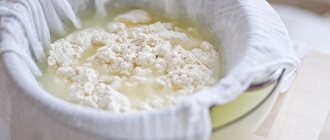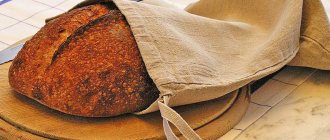Does the product have a shelf life?
The shelf life of flour depends on its storage conditions. In order to reliably preserve flour without deteriorating its quality, optimal environmental conditions have been scientifically established. The legislator approved the shelf life for each type of flour:
- high-quality wheat flour - 6-8 months;
- rye flour - 4-6 months;
- corn and soybean non-deodorized flour - 3-6 months;
- deodorized soy flour – 12 months.
There are also indicators for rooms where the product is directly located: temperature - +5...+15 °C, relative air humidity should not exceed 75%. The standards are legally enshrined in state GOST standards.
Subject to the storage conditions of flour, its quality is guaranteed. According to Resolution No. 720 of June 16, 1997, flour is included in the List of goods that are considered unsuitable for their intended use after their expiration date. The manufacturer is required to indicate the date of manufacture of flour. The countdown of the flour's shelf life begins with it.
To extend shelf life, it is important to control the conditions in which flour is stored. If the storage conditions of the product differ from the standard ones, the period during which the product will be suitable for consumption will also change.
Shelf life of different types of flour
For many, the word “flour” is associated only with wheat. In fact, there are many types of it. The powder is made from various cereals, nuts, and seeds. There are even vegetable and berry options.
The shelf life of different types of flour is different. It depends on the following factors:
- quality of raw materials and conditions of their processing and storage;
- the type of product that was ground into powder;
- degree of grinding;
- the presence of preservatives and other chemicals in flour;
- packaging quality;
- storage conditions of the product in packaged form and after opening.
Marking
When producing flour, the manufacturer is obliged to mark the date of flour production on storage containers (bags, paper bags for packaging). The marking is applied typographically or stamped to each unit of consumer packaging and contains the following information about the product:
- trademark and (or) name of the manufacturer, location and subordination;
- name of the product (type, grade and number - for graded and numbered products); the word “vitaminized” for premium and first grade wheat baking flour is distinguished as large;
- net weight (kg);
- production date and packer shift number;
- shelf life (for all types of flour, oatmeal and oatmeal);
- designation of the standard or other scientific and technical documentation for the product;
- the inscription “store in a dry place”;
- information on nutritional and energy value (calorie content) per 100 g of product, protein, fat, carbohydrate content.
On a bag made of polyethylene materials, the markings are applied to the film using a printing method or with a dater on a paper label, which is glued or inserted into the bag. During packaging, a marking label measuring 6x9 cm made of cardboard or sack paper is sewn or glued onto each bag of flour during packaging. It must also contain the same information as on the consumer packaging.
How to store flour without getting bugs
Flour and cereals are favorite places for insects. If storage rules are violated, bugs may appear in them, the larvae of which are difficult to notice. To protect products from contamination, experienced housewives place in containers:
- Unpeeled garlic (2 medium cloves per kilogram), which releases
phytoncides that repel most insects.
- Dried calendula flowers are suitable for the safety of flour stored in
linen bag. It is placed in a larger fabric package, and the space is filled with a fragrant plant.
- Bay leaf or cloves. The aroma of spices repels pests.
- Table vinegar will protect the entire contents of the cabinet from insects. For
To scare away unwanted guests, it is recommended to wipe shelves and doors with 9% acid.
There is another method that grandmothers use - they place a clean, large nail in a container of flour. Although the mechanism of action of this method is unclear, in practice it is quite effective.
How much is it and what does it depend on?
The main regulatory document for storing wheat and other flour is GOST 26791-89 “Grain processing products. Packaging, labeling, transportation and storage". They provide containers for storing and transporting flour.
Consumer containers for flour are:
- paper bags;
- cardboard packs or paper with an inner bag;
- packages of their thermowelded polymer materials.
Bags and packs must be glued together. Flour is packaged in consumer containers in 1, 2 and 3 kg, and cereals - from 250 g to 1 kg, with a multiplicity of 25 g. For transportation, bags and packs of flour are placed in boxes with a capacity of up to 15 kg.
During storage, fats are broken down and the product oxidizes. In order to extend its consumer properties, it is necessary to create conditions that prevent these processes. The simplest is to reduce the storage temperature while maintaining the same air humidity of 75%. If this temperature regime is observed, the shelf life of flour increases to 2 years.
The shelf life of flour also depends on the raw materials from which it is made.
Shelf life table for different types and grades of flour:
| Name of flour | Tara | Storage temperature, °C | Ambient air humidity, % | Shelf life, months |
| Wheat | From paper, fabric, plastic | +5-15 | 60-75 | 6 |
| Rye | Glass or plastic | +5-15 | 60-75 | 6 |
| Linen | Vacuum packaging | +15-10 | 10 | |
| Corn | Sealed | +5-15 | 60-70 | 3 |
| Oatmeal | Breathable paper (perforated) | +20 | 60 | 2 |
| Buckwheat | Made from fabric, paper | +5-+20 | 70 | |
| Rice | Glass, hermetically sealed | +5 — 15 | 60 | 6 |
| Almond | Sealed | 12 | ||
| Meat and bone | Tightly sealed packaging | Up to +30 | 75 | 6 |
| Whole grain | Sealed | +5-15 | 60-75 | 2-3 (after opening the container) |
If the packaging shows extended shelf life, then such flour is produced with the addition of antioxidant products:
- E 928 Benzoyl peroxide.
- E930 Calcium peroxide and others.
It is hardly worth using it for culinary purposes at home.
Shelf life: influencing factors
Factors the flour base, its moisture content, etc.), as well as storage conditions, namely:
Read about the expiration dates of baked goods here.
- container used for flour;
- grinding degree;
- temperature regime;
- humidity conditions;
- availability of ventilation ;
- proximity to strong-smelling substances .
Facilities specially equipped for storing flour make it possible to preserve the consumer qualities of the product for 10 years.
It is almost impossible to create such conditions in a home environment, and therefore, at best, you should expect that the product will last a maximum of 2 years .
It is difficult to imagine modern life without flour. We come across products made from flour every day, since flour is contained in many consumed products, primarily in bakery and confectionery products.
Most housewives always have flour in their kitchen. However, not all of them are familiar with the features of proper storage of this product.
Dear readers! Our articles talk about typical ways to resolve legal issues. If you want to find out how to solve your particular problem, call the free consultation numbers:
Conditions and rules of storage in warehouses
In warehouses for storing flour, conditions are created that meet SanPiN 2.3.2.1324-03 “Hygienic requirements for shelf life and storage conditions of food products,” approved by the Chief State Sanitary Doctor of the Russian Federation on May 21, 2003.
The warehouse must be ventilated and kept dry at all times. Relative humidity is maintained at 75%.
In winter, the temperature in a closed warehouse should not drop below +10°C. • Infestation with barn pests is not allowed. For this purpose, treatment schedules against pests are drawn up, taking into account their life cycle.
What do GOSTs say?
GOST R 52189-2003 for wheat flour in clause 7.2 indicates that the establishment of the shelf life is the responsibility of the manufacturer (subject to optimal storage conditions). Clause 4.9.1. it is said that each package must be marked
, as well as shelf life.
When packaging, the manufacturer, knowing the grade, grinding coarseness, and also taking into account what technology was used to bring the flour to full readiness for storage, must indicate the release date and expiration dates on the container.
At home
As with industrial storage, it is important to maintain temperature and humidity conditions at home. The permissible temperature is considered to be +20 °C (optimally +5...+15 °C), humidity - 75%. To prevent condensation from forming on the packaging, leading to the formation of lumps, it is necessary to eliminate temperature fluctuations. After opening the original packaging, the flour is poured into glass or special plastic containers with tight lids.
To increase the shelf life of use at home, flour is prepared using several methods:
- dry by spreading it on clean paper or parchment in a dry room for 30-60 minutes;
- dry on a baking sheet in the oven at 50 °C for 10 minutes;
- put in the freezer for a day.
For long-term use, flour is placed in prepared, thoroughly dried opaque containers. The best place in the apartment is considered to be:
- Kitchen Cabinet;
- pantry;
- fridge.
You should also isolate from sharp and strong-smelling products: coffee, spices.
To protect against flour pests, the following methods are used:
- Treating kitchen cabinet shelves with 9% vinegar.
- Adding a couple of cloves of garlic per 1 kg of flour to the storage container.
- A flax bag filled with flour is placed in a larger one, and the space between it is filled with dried calendula.
Useful properties of corn flour
Corn flour contains a large amount of calcium, which is necessary for strong bones and teeth, as well as for normal muscle function. It also contains potassium and magnesium, which are necessary for normal heart function.
This flour provides the opportunity for complete nutrition. By replacing wheat flour with corn flour, you can follow a diet for weight loss. If you can’t manage without bread on the table, and you don’t want to deny yourself flour products, then regular bread can be replaced with corn bread. Products made from corn flour contain slightly fewer calories, but such bread is much better absorbed by the body.
Shelf life of corn flour
There is GOST 14176-69 “Corn flour. Technical conditions”, introduced on January 1, 1970 and at the beginning of March 2020 – valid.
The shelf life of fine and coarse corn flour is 3 months from the date of production, in accordance with GOST.
But there is an opinion that if you follow the rules for preparing for storage and the storage rules themselves, as well as storing flour in a cold environment (for example, a refrigerator), corn flour can have a shelf life of up to 6 months. But it is indicated that the quality of the product will differ significantly from flour that was stored at home for no more than 3 months. Is it worth the risk?
Can it be used if time is up?
If storage was carried out in compliance with all requirements or at a low temperature, there was no change in the original properties, the flour is quite suitable for baking. If there are disturbances in the temperature or humidity of the environment in the room where the flour is stored, it will spoil:
- Rancidity . During storage, the fats contained in flour oxidize, which affects the taste. There is a process of increasing toxic substances formed during the chemical reaction. In this case, the nutritional value of the product is lost.
- The appearance of mold . When stored at high humidity, flour becomes moldy. In warm and humid conditions, molds multiply very quickly and occupy a large area. Such flour has a musty smell, which alone discourages its use.
- Souring is caused by two types of microorganisms that can break down starch and ferment flour to sugar, releasing organic acids. Their volatility explains the sour taste. With additional sifting, some of the acids evaporate and the aroma becomes less intense.
- Compaction occurs as a result of changes in the flour structure. This is a natural process that occurs under the influence of the flour’s own mass as a result of prolonged storage of the product. After sifting through a sieve, the flour is ready for use.
Once it has lost its qualities, it can be used for children’s crafts as a paste if saving money is important. Under no circumstances should such flour be used for nutrition, so as not to harm your health.
By observing the storage conditions of flour, you can increase its shelf life. There are methods for this that have been tested by time and the experience of housewives. It is better to monitor your household supplies and purchase only the required amount of the product.
If you find an error, please select a piece of text and press Ctrl+Enter.
The best container for home
How to store flour or cereal at home? Many housewives, having bought, for example, flaxseed flour or semolina in a paper bag, do not consider it necessary to pour it into another container. But after opening the package, you can no longer store bulk products in paper. The best container for storing bulk food materials is a glass container with an airtight lid. This could be a jar or container. If you find such dishes heavy, bulky and inconvenient, you can use a plastic container with rubber gaskets on the lid for a tighter fit. They are also perfect for our purpose. Lightweight and inexpensive containers can be purchased in a variety of sizes and shapes convenient for you.
Linen bags, which are very popular among advanced housewives, are well suited for storing bulk solids, dried fruits and mushrooms, crackers and bread. Flax is a natural material that allows food products to “breathe,” which means that neither your flaxseed flour nor semolina will become moldy in them and no living creatures will grow in them. They are easy to use, pleasant to the touch and take up little space.
What should you store the purchased product in if a regular two-kilogram bag is not your format? A large amount of raw materials will be stored well in linen bags or thick paper bags. Before long-term storage, be sure to dry the product on a piece of parchment paper.
How to prevent insects from appearing in flour?
To prevent flour from being infected by bugs, you need to adopt the following techniques:
- Salt is an excellent protection against insects. If bags intended for storing flour are pre-soaked in a concentrated salt solution and dried, the risk of bugs will be minimal. You can also cover the contents of a glass, plastic or metal container with such a cloth.
- The smell of garlic also repels insects, so you can put a few cloves directly into the flour.
- Dried calendula flowers are another effective remedy. True, it is used only if the flour is stored in a paper or rag bag.
There is another interesting method of preventing the appearance of insects in stocks - several large, pre-cleaned stainless steel nails are vertically lowered into the flour.
Even when all the rules for storing flour have been properly followed, at the first sign of problems, it is better to get rid of the product. If the composition becomes crusty, its color or smell changes, large lumps appear, no methods of mass resuscitation will help. The use of such a component may lead to food poisoning.











